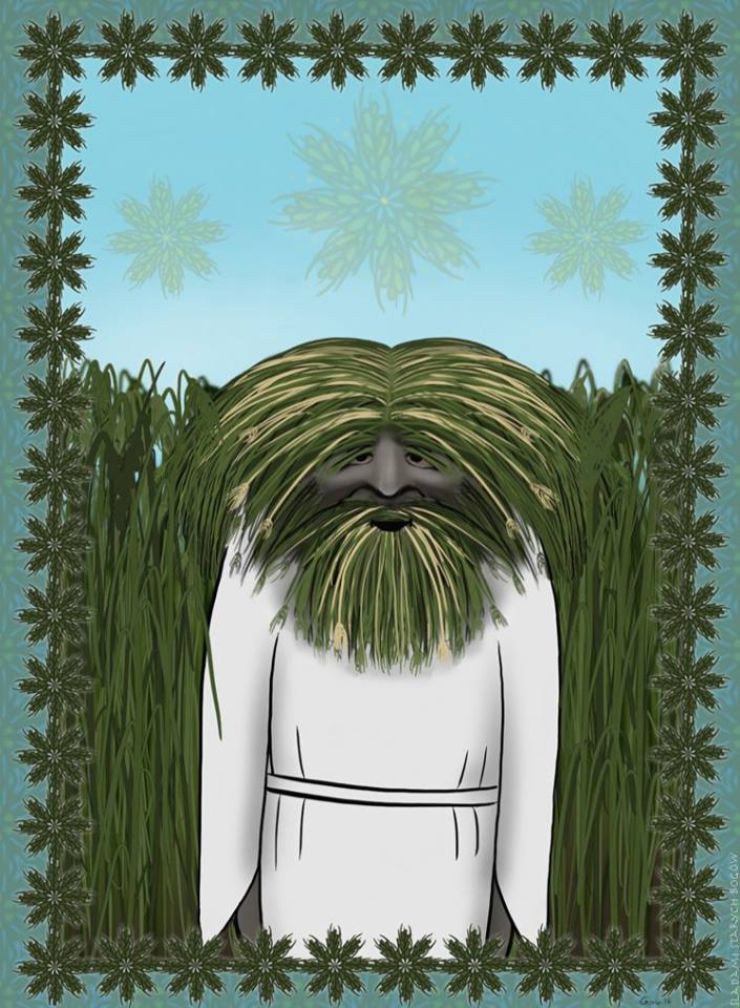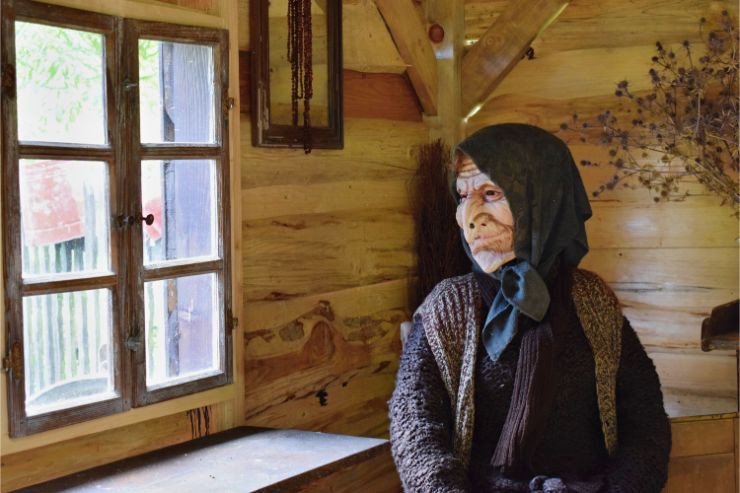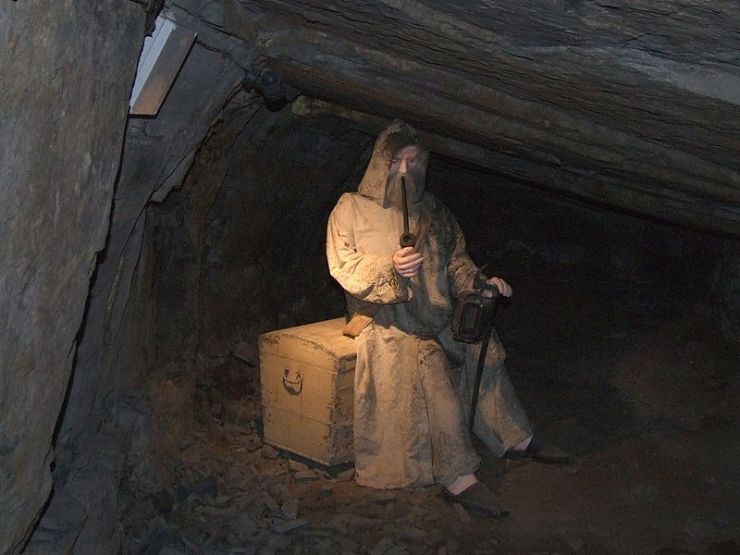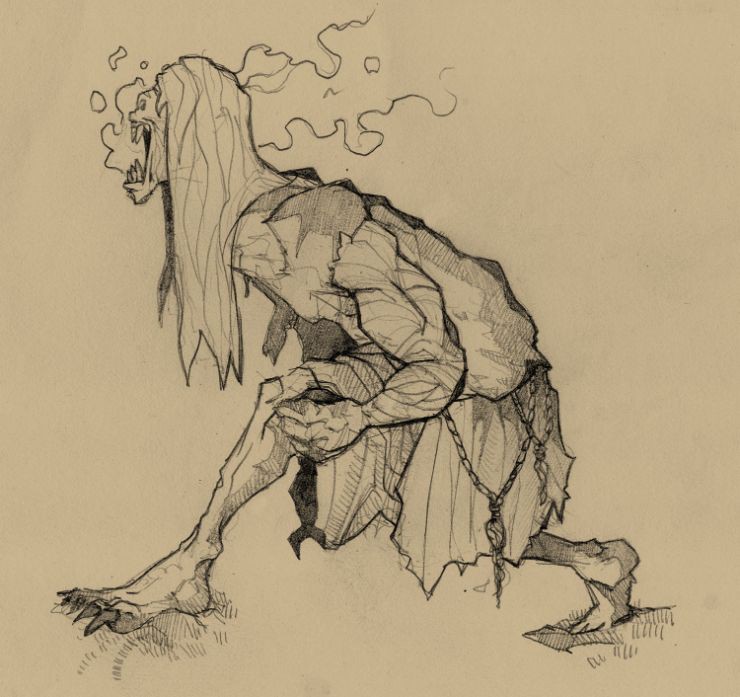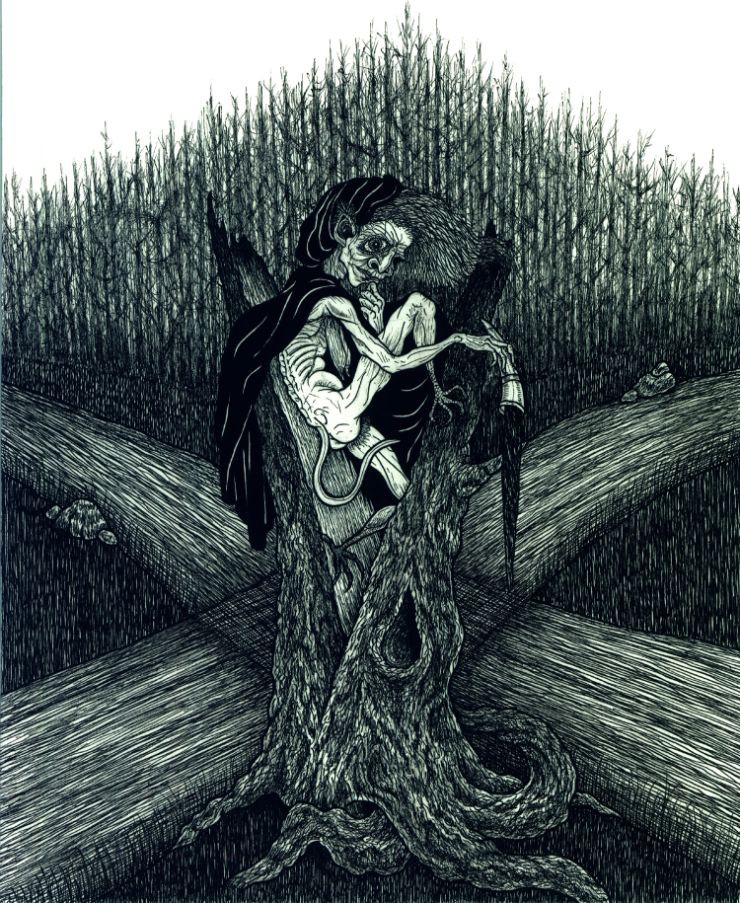Do you know the world-renowned game “The Witcher” by CD Projekt Red? It was based on novels by Andrzej Sapkowski about a man hunting down and killing monsters. What kinds? The Slavic ones, of course, because Polish folklore creatures are among the cruelest and terrifying. Meet the 20 most terrifying Polish monsters. Are you ready? Here we go!
Where did Polish mythology creatures come from? The answer is simple: they were primarily to explain reality. In the early Middle Ages, many phenomena were beyond human comprehension. The easiest explanation was to believe in the existence of higher, supernatural powers. So not just single creatures, but a whole host of Polish monsters, Polish demons and Polish mythical creatures came into being. They usually personified negative phenomena that happened to people, from the lighter ones such as lack of sleep, through all diseases, to night-time suffocation and drownings.
Is Polish folklore unique, however? Yes and no. After all, culture is the result of many factors. Werewolves and devils are also found in other beliefs. The point is that our werewolf has specific characteristics that we have given it. And that makes it ours. This is how Polish folklore creatures were created.
Meet the top 20 most terrifying Polish monsters that will make you want to become a real Witcher, an extremely talented hired monster killer. At the end, we will explain what training you have to undergo in order to learn how to fight the products of our scary folklore...
What were the Polish mythology creatures?
How can we classify our Polish demons? The easiest way would be to choose either the creature’s methods or the place where it lives. We opted for the latter, arranging our monsters in order from the least scary in a given category to ones whose very names induce dread. Such as it is, contrary to appearances, this scary folklore was not only born in the underground! In the Middle Ages, all of nature was unfriendly to people – people died both in the forests and in the mountains, or in the swamps. It was in these places that Polish mythical creatures had their cursed inhabitants.
However, no one suspected them of having come from hell! They were an element of life and part of nature, treated almost on par with all other animals. How did that happen? Let us explain. You are Mr. Smith and you’ve never saw an elephant, but you know it exists. Why? Because another Smith saw it and told you. Why should you not believe him? So believe us, too. Let the countdown begin – this is a journey through the most creepy Polish folklore demons and creatures.
Polish demons of the air
20. Latawiec/Latawica (Fiery Serpent)
Souls of miscarried children, people who were hanged, convicted villains. All of them were to be transformed into great black birds after death, affecting atmospheric phenomena. But not only that. They loved going down to earth and seducing people (hence today’s Polish dictionary of phraseologies includes the Polish “Latawiec/Latawica” as a synonym of sexually promiscuous people). And it was the latter activity that caused the idea of the fiery serpent in Polish folklore to change over time.
Through the clergy, they began to be associated with large, lewd air devils. Their favourite pastime is harassing honest and God-fearing women at night... in order to persuade them to commit the sin of impurity, of course.
What did the people say among themselves? “That Latawiec will spare no woman, he wants them all!”, “"That Latawica has done it with every man in the village”. Innocent boys, good girls – you should always be on your guard! A Latawce and Latawice have the ability to take the form of an attractive young man or a fair woman...
19. Poroniec and Alkanost
A violent and premature death caused great anxiety and fear in people in the Middle Ages. Such people were accused of contacts with unclean forces. This is how the Poroniec came to be, i.e. the souls of children who have parted the world while still in the womb or after birth, but before baptism. Such prematurely deceased children were to be guided by immense envy that they did not get to enjoy their lives.
Moreover, they were usually buried just about anywhere, in secluded spots, so that no one finds the corpse. Their souls went to eternal damnation, transforming into bird-infants, flying at night and attacking pregnant women and young children to... suck out their blood. This was to be retribution for the harm they had suffered.
Meeting a bird at night might, however, be a meeting with another Polish mythical creature, i.e. an Alkanost. However, instead of a child’s head, these night birds had the face of a beautiful woman. These were demons of the women who committed suicide after killing their child. The singing of Alkanosts would lure men, driving them mad. Whereas they themselves would lay eggs on a beach, from which a huge, uncontrollable storm would hatch!
Polish field, forest and roadside monsters
18. Południca and Północnica (Lady Midday and Lady Midnight)
The Południca, Lady Midday, Lady Rye – she had many names, although the first term was certainly the most popular. She was feared by everyone working in the field during the July and August heat. As the name suggests, she always appeared at noon, when the sun shone the most.
The Południca came as a tall, pale, thin woman with loose hair and a flowing white robe. Some saw Lady Middays as ghostly skeletons, others just as old women. Others still described them as beautiful women – no wonder, they were supposed to be able to cast a spell on a man, under which he lost control of himself.
They wielded a sickle – everyone who fell to the ground from exhaustion, sunstroke (or drunkenness!) while working the field, was probably cut down by the field blade of a Polish folklore creature.
But where did the Lady Middays come from? They were the souls of women who died tragically around their own wedding or all the girls who had died in their maidenhood. And how could you defend against them? Simply by keeping out of the fields in the midday heat.
Due to the famous “The Witcher”, the Lady Midnights are immediately associated with the Lady Middays – also female demons, but ones that would strike at midnight. This was probably another name for a night maiden, i.e. a folk monster dressed in a black dress, lurking for a wanderer at night in the wilderness or in the woods. But where did they come from? They were the souls of women who died tragically but – unlike a Lady Midday – died before their wedding.
17. Polewnik
Who was Polewnik? He was depicted as an unnaturally short man with a grainy complexion, with ears of grain instead of facial hair. Supposedly he walked the fields, sometimes at noon, sometimes at sunset, and played at the expense of those he encountered, leading them off into the field (in other words: the wrong way). He liked to strangle or trample those who fell asleep. He was particularly fond of playing with drunks, to whom he used sophisticated aggression.
By Goria ML - Own work, CC BY-SA 4.0, https://commons.wikimedia.org/w/index.php?curid=57735989
Originally, Polewnik mainly played the function as the protector of fields and forests. This, however, was taken over by Veles/Leshy, and our field dwarf was quickly degraded to the rank of an infernal creature.
16. Hags – Baba Yaga
The very name of Baba Yaga from the Proto-Slavic word for “hag” was supposed to be associated with horror, torment, threat, and of course with the colloquial name “hag”, which describes rude old women.
Baba Yaga can be found in the middle of the forest – here her famous mythical house on chicken legs was supposed to be. She was accompanied by a black cat, although some legends mention a crow, a snake or an owl.
What did she look like? Hag-like, of course: short, a hideous old woman with sagging breasts and poor eyesight. She would feed on small children who got lost in the forest. First, she would lock them in a cage and fatten them up, and when they were all plump and tasty enough, she would bake them in the oven. Not only Polish children were scared of her – hags are present in almost all Indo-European mythologies.
15. Werewolves
How about a man who can turn into a wolf? Behold the werewolf, whose transformation is accompanied by a whole range of demonic aspects. He was very deadly – he murdered people and animals brutally, unable to control his own aggression.
How did the transformation happen? There were several versions. Some believed that it was the result of a wolf bite, others claimed it to be a curse or a charm. According to legends, there were also those who allegedly indulged in black magic willingly, in order to get revenge or bring justice.
Water creatures from Polish swamps and lakes
14. Rusalka and Vila
Time for Polish water folklore. A Rusalka or water demon lived on the banks of lakes and rivers. These were most often women who had drowned before getting married. They appeared as beautiful, naked or half-naked women, clad in airy shirts or silver robes, with fair skin and long green hair; their heads were adorned with wreaths of riverside flowers and herbs. Apparently, in them enchanted power of these Polish demons was found. They tempted men and caused their death by drowning them in a nearby lake. Sometimes they also indulged in a mad dance with the unfortunate fellow, until he fell from exhaustion.
The latter way was also used by Vilas – the south-Slavic equivalent of a Rusalka. However, these were rather capricious than cruel – sometimes they blinded the men they encountered, and sometimes they were able to help them get married. However, they would always put the man to the test and tempt him with their beautiful young bodies.
13. Utopiec, Yopielec, Vodnik
The shores of all inland waters were considered to be particularly dangerous places for all bathers, fishers and drifters. Why? Because there were often drownings and unfortunate accidents. And it was the souls of those who died tragically in the water that became an Utopce or Topielce (the name varies depending on the region).
They were depicted as deformed people with scales and with fingers covered with membranes. They basked at the banks near bridges and footbridges, and then suddenly pulled people into the water. Sometimes these Polish monsters, like the Sphinx, would ask their victims riddles on which their fate depended. However, these were rarely guessed.
Vodniks, on the other hand, were slightly different from an Utopce or Topielce. They were supposed to be short elderly people with green fish eyes who not only drowned specific people but were responsible for all floods and floodings. Therefore, offerings were given to them from time to time, in the form of house pets, to ensure their favour. Did it work? It’s hard to tell ... Supposedly, for entertainment, they would sometimes place trinkets on the water to lure daredevils to the middle of the waters and never let go of them.
Still, the most feared were children-Utopiecs, meaning those that had drowned accidentally and also those murdered by their own mothers. The cruellest and most stubborn of them were said to not spare anyone until they murdered him. That sure sends shivers down one’s spine, doesn’t it?
12. Mamuna/Dziwożona
And here’s women again... This time old ones, with long and sagging breasts and a terrifying appearance. What did they do? They would switch children with so-called changelings, meaning their offspring. These Polish demons were very intelligent. They would watch a young mother for a long time to react in just the right moment. They would also sometimes use tricks to lure her as far away from her child as possible. It was their revenge for their own death in childbirth or during pregnancy.
Was there any way to protect against them? A red ribbon on the child’s hand and a red hat would do the trick. It was also best not to approach their habitats, i.e., all the wetlands, bogs and cavities hollowed out on the riverside slopes.
And if you did not succeed, could you recognize a changeling placed by a Mamuna/Dziwożona? Such kids had a big belly, a disproportionate head, very thin limbs and a hairy body. And their favourite pastime was emptying the pantry, including the alcohol stash. They usually died before growing up.
11. Błędne ogniki (Will o’ the wisps)
Do you sometimes admire the fireflies when you see them at night? These small lights floating above the ground are yet another type of Polish folklore creatures! They were believed to be the souls of wicked people, usually land surveyors or unjust landowners. They loved leading people astray. So if you ever feel like following a firefly, be careful! Without fail you will end up in the swamp... So inconspicuous and yet so dangerous!
Polish demons of the mountains and underground
10. Liczyrzepa (Rübezahl)
He had many names. Sometimes Rzepolicz, sometimes Karkonosz, and sometimes the Mountain Spirit. The most popular name, however, is Liczyrzepa, inseparable from Polish mountain folklore, especially in the Karkonosze Mountains.
Who is this demon then? Usually it is a deer standing on its hind legs with a devil’s tail and horse hooves, holding a long vertical stick in his hands.
However, this is again only one of the versions. According to another, Liczyrzepa is an old man leaning on his staff, looking like Tolkien’s Gandalf. When going to Karkonosze, you had to carry a black rooster – only this offering could appease the mountain demon. What would befall a passerby who had no offering? No one knows, because such a daredevil never made it back from Polish mountains...
9. Treasurer
Not only the mountains aroused fear, however. Even more terrifying was the underground. One of the underground demons was the Treasurer, who lived in mines and guarded the treasures buried there. Clearly, miners feared him the most. Their fate depended on this spirit’s mood. Seeing the laziness of workers or simply on a whim, he could cause a collapse, flooding and even a fire. He was also ruthless and vindictive towards all dishonest miners as well as those who did not like their work.
By Krystian Hasterok - Own work, CC BY 2.5, https://commons.wikimedia.org/wiki/File:Subterranean_Skansen_Guido_Zabrze_08.jpg
He was depicted as an old man with a long grey beard, in a linen cloth robe, holding a pickaxe and a miner’s lamp. One could see him in the dark due to his eyes glowing red or green. He also liked transforming e.g. into a mouse, a black dog or a frog. Sometimes he was also invisible – his arrival was heralded by a disturbing tapping sound...
8. Devil (fiend, chort)
And again we’re back to the surface for a moment, to the mountain areas, to meet with one of the most terrifying Polish mythology creatures, namely the devil, usually referred to as a fiend or a chort in Poland. Who was he? An evil, troublesome demon, of course. Funny enough, though, he limped on one leg. He lived in the mountains, but primarily forest and swamp areas.
It is said that it fiends contributed to the forming of mountains (due to a big conflict with the so-called chads, i.e. devils from abroad). It was then, apparently, that our chort received a massive kick that caused his disability. However, due to Christian influence, the limp was associated with falling from the sky.
In any case, although he was lame, you’d do well not to underestimate him! He could change his appearance as well as enter specific people and direct their actions! He brought disease to people, urged them to kill and even to commit suicides. In his original form, he most often appeared with his tail cut off, short legs, horns and goat’s hooves.
Sometimes, however, our native devil liked to play with people. And so he supposedly once offered the Polish nobleman Twardowski a small deal – the man would sell his soul to him and, in return, would receive great knowledge of magic. The cunning Pole forced the devil to sign a chirograph: he would only take his soul to hell if he went to Rome, and Twardowski never intended to go there. The Polish demon, however, was far more cunning and caught up with the nobleman in a tavern called Rome. The tavern still stands in Sucha Beskidzka! So if you want to see where our devil caught up with the uppity noble, you now know where to go!
And in Krakow you can visit the Twardowski Rocks – a rock formation formed after alleged explosions in the nobleman’s alchemical laboratory.
Vampire creatures
7. Bebok (Bogeyman)
Let’s now discuss the most terrifying products of Polish folklore. Let’s start with the Bebok: also called a Bobok in Małopolska and Wielkopolska, and a babok in Kujawy.
What did he look like? Here everyone agrees – like a night Bogeyman with the height of a child, with a large and extremely ugly aged face, and all hairy. Yuck! The perfect monster to scare your children with – Bebok was supposed to scare naughty children who didn’t want to sleep.
However, he was far too stupid to act on his own, so he carried out the orders of witches. Thus the legend arose, claiming that Beboks are the souls of children who died early and who did not listen to their parents. So they liked making mischief and destroying various objects in others’ homes. And once they had their fun, they took other disobedient children with them.
6. Zmory and Dusiołki (Mares and stranglers)
While nature-related creatures could be appeased somehow, vampiric beings were absolutely ruthless. While Beboks scared children at night, the adults were haunted by mares – ghastly souls that tormented, strangled and sucked blood from humans. These were the souls of those who were harmed in some way. Therefore, sometimes they were tall women with unnaturally long legs, and sometimes shapeless ghosts. The mares could pass through every door. How to recognize that they have just visited you? If you are sweating and kick around in your bed, this is a sign that it’s time to wake up quickly...
If you succeed and feel the characteristic pressure in your chest after opening your eyes, it means that you were visited by a strangler instead of a mare, which has only one purpose: to choke you in your sleep.
5. Upiór (Wraith)
Slavic creepy folklore also knows the wraith – a Polish equivalent of vampires, now popular around the world thanks to the “Twilight” saga.
What does it look like? It is a ghost filled with blood, with a soft, shaky and unstable body (without any meat or bones). Do you know where it came from? Wraiths were thought to be living corpses. If, after digging up the grave, the face of the buried person was still ruddy, and the casket lid intact, that meant the soul had turned into a demon. Sadly, this belief came from a rather frightening fact, namely the fact that in the Middle Ages it quite often happened for people to be buried alive by mistake...
It was believed that red-headed, left-handed, and people with overgrown eyebrows became wraiths. And their graves were later unearthed to check the state of the corpse. However, these Polish demons were also those who were not buried, or who were missing or banished from their village. In any case, a wraith would wake up at night and go hunting – devouring the insides of the unlucky victim or draining their whole life. So it was worth carrying a few articles for protection: garlic, silver or a stake. Each of them could be used to kill the terrible monster. And if you knew who the demon was, you had to unearth their grave, pierce the body with the stake, cut off their head, put it between their legs and turn them on their stomach. No big deal, right?
4. Strzyga and Strzygoń (Strigs)
The Polish variety of vampiric creatures is really wide and diverse. But certainly, the Witcher has made Strigs the most popular among the untameable Polish demons. They most often appeared in the form of a ghastly woman (please do not think that Poles are misogynists! It just sort of came out that way...) or a black bird. A strzygoń is the later male equivalent when it was noticed that there were too many demonic women in this repertoire.
By Filip Gutowski, CC BY-SA 4.0, https://commons.wikimedia.org/wiki/File:Strzyga_Strix.jpg
According to accounts, Strigs were people with two souls, two hearts and a second row of teeth. Such individuals were banished, and they quickly died, unable to cope with the new conditions. So one soul would then leave the body, and the other remained taking revenge on people for the wrongs they had done. The Strigs drank blood and ate people’s insides. The only way to defend against them was to burn their bodies or pierce them with a nail. This was easier said than done, however – the insatiable and powerful Strig showed animal-like aggression.
3. Licho (Likho)
The number of Polish proverbs with the word “licho” is really impressive. This was an exceptionally evil Polish demon – the epitome of all human woes, illnesses and disease in this world. You probably already know what form it was portrayed in – an overly skinny woman, with one big eye in the middle of her forehead (almost like the Cyclops).
By Mhapon - Own work, CC BY-SA 4.0, https://commons.wikimedia.org/wiki/File:Licho.jpg
Likho would wander around looking for places where people are happy. Then came the time to play – sending hunger, poverty, fires and whatever calamities that came to the monster’s head. There was no defence against it – you had to be resilient and patient in waiting for better times. This is some good explanation for every misfortune, isn’t it? After all, this is all Likho’s doing...
2. Morowa Dziewica (Plague maiden)
Certainly one of the most terrible Slavic monsters. Before a plague arrived in a city, it would fly around at night in the form of a skinny woman, a skeleton or a bloody sheet. Sometimes, for convenience, she would mount a passer-by and sit on his or her shoulders, ordering this person to wander around villages and towns, waving a headscarf and bringing down mass death in terrible torment.
But it was not only about death. The Plague Maiden raised such a monstrous terror that people would go mad: they would set fires, murder others (even their own children!), attack the healthy. This creature could neither be tamed nor calmed down. It was not only the most terrible but also the final and inevitable.
Fantastic monsters from legends
1. Dragons
What is number one? Dragons, of course! These mythical creatures, appearing in legends and stories for centuries, now found their way into literature, films and games around the world. However, as you may know, these fire-breathing monsters, gifted with high intelligence, magic, knowledge of human speech, are not a Polish creation. So why are they at the top of the list of the most terrifying Polish folklore creatures? Because, as is the case with many common European monsters, Polish folklore includes several dragons that are genuinely ours.
The first of these is Bazyliszek, who first resided in Krakow, and then moved to Warsaw. According to a popular urban legend, it was a terrifying creature (described as a rooster, snake or turkey with a tail and frog’s eyes), which guarded treasures hidden in the old town underground, and killed intruders with his stare.
This one, however, can’t even compare with the most famous Polish dragon, i.e. the Wawel Dragon. This cross between a lizard and a crocodile, a snake and a bat primarily feasted on local virgins. Do you want to know what happened to it and why is it nicknamed “Wawel”? Be sure to buy a ticket and meet the Polish dragon, thanks to Discover Cracow and the tour to the most famous kings’ castle in Poland!
Polish folklore – how to defeat its dark side?
As promised, here is a short guide on how to defeat these Polish folklore creatures. The world knows of the “witchers” – killers of these miserable demons. How to become such a hero? All you need to do is learn how to suppress all emotions, move faster and quieter than all existing creatures, memorize the whole bestiary, start making potions that will increase your agility in combat, and finally do a little magic. Sounds trivial? If you don’t feel like coming face to face with these Polish mythical monsters, put your ear to the extraordinary stories about them with the Discover Cracow tours!

